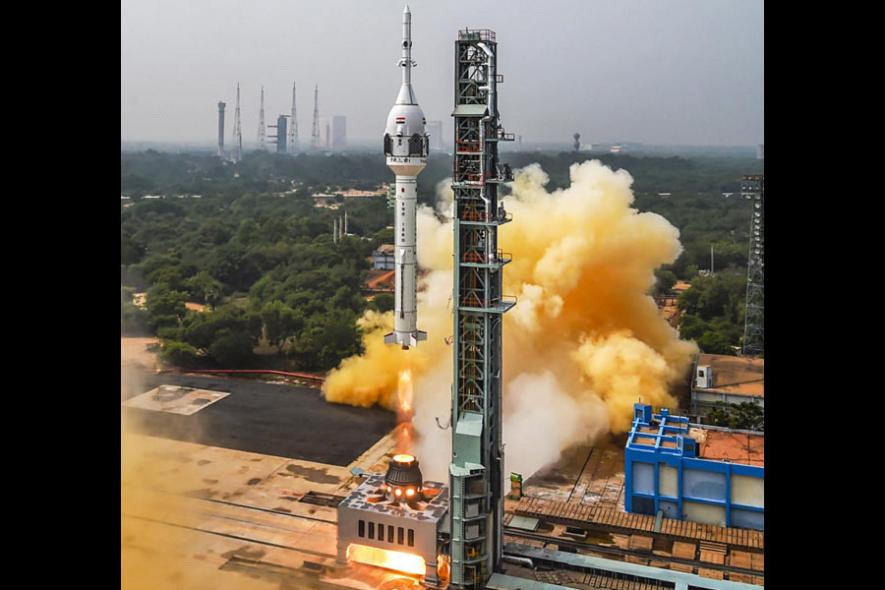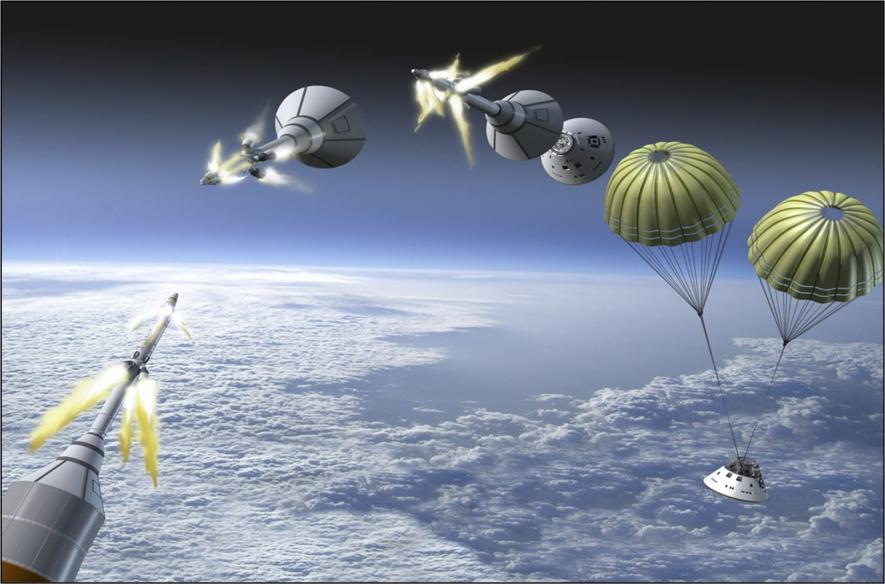Making Way for Objective Assessment of ISRO's Space Achievements

Image credit: PTI
One thing that has always been known about human space flight, is that it is very dangerous. So far, 19 astronauts or cosmonauts (we will use the former term here for simplicity) have died in space accidents, which is a relatively high of approximately 3% compared to other forms of transportation. Significantly, only three of these fatal crewed space flights had flown above the Karman line, symbolically marking the edge of space at 100 km above the Earth. Most fatalities have occurred during the launch phase or during re-entry, especially the former. That the launch phase should be the most dangerous is understandable since astronauts are strapped into their seats atop a rocket filled with hundreds of tons of highly inflammable fuels, a veritable bomb that is virtually impossible once fully ignited.
It is therefore unsurprising that a key milestone in ISRO’s preparations for the impending Gaganyaan mission to launch a crew to low-earth orbit at about 400 km altitude for a few days, should be the testing of a Crew Escape System designed to safely take the crew well away from the rocket the eventuality of a dangerous malfunction on the launch pad or at different altitudes into the flight.
On October 21, 2023, ISRO successfully did just that. Its Gaganyaan Test Vehicle Abort Mission Demonstration 1 or TV-D1, carrying a full-scale unpressurised model of the Crew Module (CM) on top, took off from the Sriharikota Space Centre. At a predetermined altitude of 11.7 km and velocity of 1.2 Mach, just past the speed of sound as per the planned trajectory of the Gaganyaan mission, a simulated abort condition fired the rocket motors of the Crew Escape System (CES) taking the CM attached to its base along with it and away from the launch vehicle. Then, as the CES with CM in the planned sequence at appropriate altitudes, the CES was jettisoned at 17 km altitude and Mach 0.5, a drogue parachute was deployed at 16.7km to start slowing down the CM, which performed a series of manoeuvres to reorient itself in the base down position, then deployed its main parachutes and splashed down about 10 km from Sriharikota in the Bay of Bengal from where it was lifted out by an Indian Navy vessel.

Latest in a long series of developments
When it comes to events in India’s space programme, it is becoming a habit in the media to write gushing stories, desperate to report “firsts” or at least “unprecedented success.” Besides being misleading, such reporting prevents a calm, objective assessment of achievements and tasks ahead, especially in the light of international experience and achievements of other space-faring nations. Reportage on ISRO’s successful Crew Escape System test has been similar, making readers think this was something new, a first-of-its-kind test in preparation for the crewed Gaganyaan mission ahead.
A quick review would show that the recent test was but the latest in a long series of efforts by ISRO towards crewed space missions dating back over two decades.
Preliminary studies and other efforts towards crewed missions started back in 2006 under the generically named “Orbital Vehicle,” whose aim was to take a crew of two to low earth orbit for about a week and bring their capsule back to splash down in the sea. The project was commissioned in 2007 with a target date of 2024, and received funding in 2009 as the Indian Human Spaceflight Programme, with an uncrewed spaceflight expected in 2013. However, many doubts persisted at different levels of government, reflecting the dilemma of that period between development-oriented and exploration-based space programmes, and leading to the programme almost being cancelled, till it was finally given the go-ahead in early 2014.
Meanwhile, a scaled-down crew module was designed, fabricated, launched, and recovered at sea in 2007, followed by a full-scale mock-up for the training of crew in 2009. After proving many other technologies such as the heavier GSLV Mk 3 (now renamed LVM3), improved crew modules, flight suits from the Defence Bio-engineering and Electro-medical Laboratory (DEBEL) to supplement suits made in Russia, and early tests of the crew escape systems, the full programme was green-lighted on August 15, 2018.
Several crucial technology elements were developed and tested over the next few years. A new single-stage liquid engine rocket used in TV-D1 was among these, along with specially designed quick-response solid-fuel rocket motors for different components of the Crew Module and Crew Escape System. These last two were separately developed and subjected to several rigorous tests. The Crew Module (CM), originally designed by Hindustan Aeronautics (HAL), Bangalore, is now fabricated by Bangalore-based private company Alpha Design Technologies along with other important components.
The Crew Escape System (CES) developed by ISRO itself has been through different tests. A Pad Abort Test to evaluate performance in case of emergency on the launch pad itself was conducted in July 2018 in which the CM with CES was launched from the pad by their own independent rockets up to an altitude of about 2.7 km at speeds within the G-forces (gravitational forces felt during fast, accelerated and curvaceous motion as in fast automobiles, fighter aircraft, rockets, etc.) that astronauts would be expected to face, and then splashed down in the sea a few kilometres from Sriharikota.
The October test at a relatively high altitude was the latest in this long series and assessed the performance of the single-stage rocket, the CES, and the quick-reaction solid motors on the CES and CM.
Over the next few months, tests of the CM, such as being dropped in the sea from a helicopter and another Pad Abort Test, would be conducted again due to recent design changes. It is better to be safe than sorry!
Need and Design for CES
While the need for a CES has been felt since the very beginning of crewed spaceflight, its necessity was brought home most sharply in the horrific accident of the Space Shuttle Challenger on January 28, 1986, when it exploded 73 seconds into its flight killing all seven crew members aboard although, in all probability, most of the crew were killed when their spacecraft crashed into the sea. The Shuttle was deemed to be so safe and reliable that no CES had been fitted to it.
The ejection seats used in combat aircraft were rejected as an option because it would involve fitting explosive charges under the crew seat inside the crew module, deemed too risky with so much fuel on board. Two other options were for the crew to quickly exit the cabin back into the lift that brought them to it and back to the launch pad. The other option, still in use in some launch sites in the US is for the crew to exit via a platform from where they would slide down zip-lines in single-person bucket seats descending many metres away from the rocket. But all these are if an abort signal is given while still on the launch pad and before the full ignition sequence has commenced.
The Shuttle had another device for eventualities when it was descending in a glide mode. A set of long pipes would extend out of a side hatch and crew members would slide down them for several metres till they were free and far from the craft and could deploy parachutes.
However, for full-fledged emergencies either on the launch pad or well into the flight, other more drastic measures were required which would almost instantaneously take the crew well away from the rocket to safety.
Two options have been, and still are, around. The first is a “push” model where a ring with rockets is fitted under the Crew Module (CM) and which would blast and carry away the CM when actuated either manually or automatically upon receiving warning signals. The second option is a “pull” model where a rocket-powered system is fitted on top of the CM which fires its motors and shoots up and to the side pulling the CM after it.
The push model is simple to construct and operate, but means that if there is no emergency, the considerable weight would have to be carried all the way along with the CM implying a great deal more expense. The pull model is more complex. It must fire its rockets far enough away from the Crew Module, using rockets which fire upwards but have reverse nozzles which direct the thrust downwards and at an angle away from the CM so as to avoid burning up the CM. The tower carrying this complex arrangement is extremely heavy, for example, 8 tons compared to just 4 tons for the ISRO CM but with the advantage that the whole CES is jettisoned either after use or after successful completion of the launch cycle.
Currently, both Jeff Bezos’ Blue Origin and Elon Musk’s Dragon use the push model, as apparently will the future NASA systems for the Artemis Mission.
Earlier, NASA had always used this pull model. ISRO’s CES is remarkably similar to NASA’s design!
With all this, one can look forward to Gaganyaan’s 2024 orbital mission, then India’s Space Station, and then landing a crew on the Moon envisaged for 2040.
So far so good. But this still leaves us with the dilemmas of yesteryear. Is so much effort into crewed missions really worth it? Almost all scientific missions can be carried out using robots, which are becoming more capable and sophisticated by the day. There is little doubt that the current frenetic activities in space, especially on the Moon involving the US, China, India and a limping Russia have more to do with prestige, demonstrating technological prowess, and geo-politics. The US is far and away ahead of all others in deep space exploration and science. Who knows what the situation will be in 2040? Will we still look back and say this has been worth it?
Get the latest reports & analysis with people's perspective on Protests, movements & deep analytical videos, discussions of the current affairs in your Telegram app. Subscribe to NewsClick's Telegram channel & get Real-Time updates on stories, as they get published on our website.
























